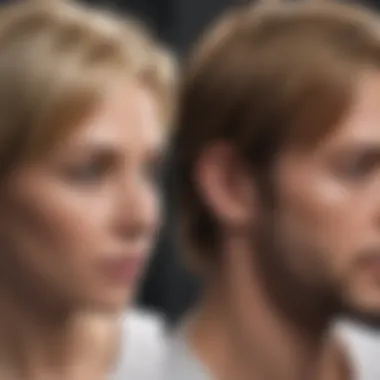Effective Treatments for Bleach Damaged Hair


Intro
Bleaching hair can produce stunning results, shifting the color to a brighter or lighter hue. However, it often comes at a price. The chemicals involved in the bleaching process can cause significant damage. This damage may manifest as dryness, breakage, and frizz. Understanding how to treat bleach damaged hair matters for anyone who wants to maintain healthy locks while enjoying color transformations.
In this article, we will look into what causes bleach damage, effective treatments to restore hair health, and how to care for your hair after applying these treatments. Each aspect is essential for making informed decisions regarding hair care and maintenance.
Understanding Hair Damage from Bleach
Hair bleaching is a popular technique for achieving lighter shades and vibrant highlights. However, it is important to understand the potential damage it can inflict on hair. Knowledge about hair damage from bleach aids in making informed choices for treatment and recovery. This understanding is vital for maintaining hair health, especially for those who frequently bleach their hair. Knowing the effects of bleach, the symptoms of damage, and the severity of that damage can directly influence the effectiveness of subsequent treatments.
The Chemical Process of Bleaching
Bleaching hair involves a chemical reaction that alters its structure. The primary agent used in bleaching is hydrogen peroxide. This compound penetrates the hair shaft and oxidizes the pigment molecules present in the hair. As a result, the color fades, and the hair turns lighter.
During this process, the outer layer of the hair, known as the cuticle, can become compromised, allowing moisture and nutrients to escape. This contributes to feelings of dryness and fragility in bleached hair. Knowing this process can help individuals appreciate the importance of post-bleach care.
Common Symptoms of Bleach Damage
Identifying symptoms of bleach damage is crucial. Common indicators include:
- Dryness and brittleness: Hair may feel straw-like and lose its natural shine.
- Breakage: Increased hair fall or split ends can occur.
- Tangled hair: Detangling becomes more challenging due to rough cuticle surfaces.
- Loss of elasticity: Healthy hair is elastic, while damaged hair often lacks this quality, leading to potential snapping.
Recognizing these symptoms empowers individuals to take timely action.
Identifying the Severity of Damage
Assessing the severity of bleach damage is an important step in determining the appropriate treatment. Damage can vary from mild to severe, and this can be understood by examining the hair's condition:
- Mild damage: Hair may exhibit slight dryness or frizz but retains most of its strength and sheen.
- Moderate damage: This level is characterized by noticeable brittleness, increased tangling, and some breakage.
- Severe damage: In this state, hair may be extremely weak, frayed, and prone to falling out.
Often, a simple strand test can help. Gently pulling a hair strand; if it stretches considerably without breaking, it indicates moderate damage. If it snaps easily, damage is likely severe. Promptly recognizing severity guides individuals toward suitable recovery methods.
Immediate Care for Bleach Damaged Hair
Immediate care is crucial after bleaching hair. The harsh chemicals in bleach can significantly alter the hair's structure. A timely response can prevent further damage and promote recovery. It's essential to address the initial effects of bleach before moving on to longer-term treatments. Poor immediate care can exacerbate problems, leading to brittle strands and increased breakage. Therefore, understanding how to care for newly bleached hair is fundamental for anyone seeking to restore their hair's health.
First Steps After Bleach Treatment
After a bleaching session, the first actions you take can make a substantial difference. Start with rinsing your hair immediately after the treatment. Use lukewarm water instead of hot, as it helps to seal the cuticles without causing additional stress.
Next, avoid shampooing your hair right away. Your hair needs time to recover from the stripping effect of bleach. Instead, consider applying a gentle conditioner designed for damaged hair. This can provide some much-needed moisture. Look for ingredients like hydrolyzed proteins or vitamin E which promote healing. Applying a leave-in conditioner can also offer extra hydration and protection.


It is also wise to refrain from heat styling tools in the initial days post-treatment. Allow your hair to air dry. Exposure to high temperatures can lead to increased damage when hair is already weak.
Choosing the Right Shampoo and Conditioner
Selecting an appropriate shampoo and conditioner is essential for maintaining hair health after bleach damage. Opt for products that are sulfate-free. Sulfates can strip away natural oils, leaving hair even more vulnerable. Look for moisturizing and nourishing formulas that can replenish lost components. Brands like Olaplex and SheaMoisture offer specific solutions for color-treated hair.
When choosing a conditioner, focus on those that contain natural oils and proteins. Both help restore moisture levels and strength. It is also beneficial to seek out conditioners that are rich in emollients. These help to smooth the hair cuticle and reduce frizz.
Incorporate a weekly deep conditioning treatment into your routine. This will help repair and hydrate your hair over time. Using a product that combines keratin can also further strengthen the hair shaft, making it less prone to damage.
"Proper use of shampoo and conditioner is a critical step in the recovery process for bleached hair."
Maintaining a regular hair care routine with the right products can create an environment for healing and regeneration.
Professional Treatments for Repairing Bleach Damage
The consequences of bleach damaged hair often require more than just at-home remedies. Professional treatments play a critical role in restoring the integrity and overall health of the hair. They offer advanced formulations and techniques that are designed to penetrate deeper than standard products, providing effective results in a shorter amount of time. For individuals experiencing significant damage, consulting with professionals can result in a tailored treatment plan. This approach not only addresses the existing damage but also helps to protect hair from future harm.
Professional treatments can rejuvenate your hair by repairing structural damage and adding necessary nutrients.
Keratin Treatments
Keratin treatments involve the application of keratin, a natural protein that makes up much of our hair. These treatments are formulated to smooth the hair cuticle and reduce frizz while providing a protective layer. For bleach-damaged hair, keratin can significantly improve manageability and shine. After treatment, hair looks healthier, feels softer, and is easier to style.
The process usually involves applying the keratin solution to clean hair, followed by heat application. This helps the protein penetrate the hair shaft. While keratin treatments yield immediate results, they last several weeks. However, it's important to choose a reputable salon, as some formulations may contain harmful chemicals.
Deep Conditioning Treatments
Deep conditioning treatments are essential for recuperating hair that has lost moisture and elasticity due to bleach. These treatments typically contain rich oils and proteins that hydrate and nourish. They strengthen hair strands and enhance softness.
Many salons offer customized deep conditioning treatments that can target specific issues related to bleach damage. The treatment is often applied after shampooing, left for a significant time, and then rinsed out. The recovery process can take multiple sessions, depending on the severity of damage. Regular deep conditioning can prevent future damage and maintain optimal hair health.
Olaplex or Similar Bond Building Treatments
Olaplex is a professional treatment designed to rebuild the disulfide bonds that are broken during the bleaching process. The main advantage of this treatment is its ability to provide structural strength to the hair. By restoring these bonds, Olaplex mitigates further damage and enhances the overall resilience of the hair.
This treatment can be performed in-salon and is often used as an additive during the bleaching process to help reduce damage. Following this, at-home treatments are available for ongoing maintenance. Users can often notice a dramatic improvement in hair texture and durability, making it a popular choice for those dealing with bleach damage.
Choosing the right professional treatments can greatly influence the recovery of bleach-damaged hair. The decision should consider factors like hair type, damage severity, and personal preferences. It is prudent to consult with a hair care specialist, who can suggest the most effective options tailored to individual hair needs.
At-Home Remedies for Bleach Damaged Hair


At-home remedies play a crucial role in addressing bleach-damaged hair. These methods are accessible, cost-effective, and rely on natural ingredients available in most households. Utilizing these remedies not only helps restore the hair's health but also allows individuals to incorporate treatments into their regular hair care routines. Unlike some commercial products that may contain harsh chemicals, these home options can be gentler alternatives. Moreover, many at-home remedies are formulated using ingredients rich in vitamins and nutrients that are known to hydrate, strengthen, and revitalize hair. In this section, we will explore various at-home remedies, focusing on their effectiveness and ease of use.
Natural Oils for Hair Recovery
Natural oils are often heralded for their moisturizing and nourishing properties. Each type of oil has unique qualities that contribute to hair recovery. They can penetrate the hair shaft and help restore lost moisture, making them a popular choice among those looking to rejuvenate their bleached hair.
Argan Oil
Argan oil is famous for its high levels of fatty acids and vitamin E. This oil helps to deeply moisturize and repair damaged hair. Its lightweight texture makes it easy to apply without leaving a heavy residue. Many people find that argan oil reduces frizz and promotes shine, which are critical factors for bleached hair. However, it can be relatively pricey compared to other oils, and some may find it difficult to source high-quality argan oil.
Coconut Oil
Coconut oil is well-known for its ability to penetrate the hair cuticle. This property allows it to prevent protein loss and promote healthier hair. The key characteristic of coconut oil is its richness in lauric acid, which provides excellent hydration. Its common use in many hair care routines reflects its popularity. However, using too much can lead to greasiness, and it may not be suitable for everyone, especially those with fine hair.
Olive Oil
Olive oil stands out for its ability to deliver deep moisture and shine. It contains antioxidants that can also promote overall scalp health. Another advantage is its availability, as many people already have olive oil in their kitchen. However, its heavier consistency can weigh hair down if not used in moderation. Thus, it is important to apply it sparingly, particularly for fine or thin hair types.
Protein Treatments Using Household Ingredients
Protein is essential for hair recovery as it strengthens the hair structure. Household ingredients can be transformed into effective protein treatments, making them a convenient choice for those wanting to repair bleach-damaged hair.
Egg Masques
Egg masques are rich in protein, making them an excellent option for hair recovery. The proteins found in eggs can help rebuild the hair's structure and enhance elasticity. Additionally, egg yolks contain fatty acids that enrich hair with nourishment. However, the smell can be off-putting for some, and proper rinsing is necessary to avoid residue.
Greek Yogurt Packs
Greek yogurt is not only nutritious for consumption but also for hair treatment. It contains proteins and lactic acid, promoting moisture retention and smoothing the hair's surface. This makes Greek yogurt a beneficial choice for those with dry or frizzy hair. A downside might be its thicker consistency, which can be difficult to apply evenly throughout the hair.
Avocado Treatments
Avocado is a nutritional powerhouse, rich in vitamins and healthy fats. Avocado treatments provide hydration and help strengthen the hair. The unique feature of avocado is its ability to nourish not only the hair but also the scalp. However, the preparation can be time-consuming, and some may experience difficulty in rinsing it out entirely.
Hydrating Masks to Restore Moisture
Hydrating masks are essential for capturing moisture, particularly for hair suffering from dryness after bleach. These masks can be made with various natural ingredients, offering a simple way to infuse moisture back into hair.
The application of hydrating masks can provide immediate relief to crispy ends and restore softness. Regular use of hydrating masks can significantly improve manageability and softness in bleached hair, making them a valuable part of any at-home treatment routine.
Incorporating these at-home remedies into a hair care regimen can not only help with recovery but also offer a therapeutic experience that promotes self-care.


By understanding these options, individuals can choose remedies best suited for their needs and effectively support their hair's recovery journey.
Additional Tips for Hair Maintenance
Maintaining hair that has been damaged by bleach is a crucial part of its recovery process. Proper hair maintenance not only helps in restoring lost health but also preserves the color and texture achieved through treatments. By adopting a strategic approach, you can significantly improve the quality of your hair over time. The focus in this section will be on forming routines, avoiding harmful practices, and correctly managing drying and styling methods.
Creating a Suitable Hair Care Routine
A consistent hair care routine is foundational for addressing bleach damage. This routine should blend cleansing, conditioning, and occasional treatments tailored to nourish your hair. Start by selecting sulfate-free shampoos and rich conditioners specifically designed for damaged hair, such as the Redken Extreme Shampoo or the Joico K-Pak Conditioner. These products are less harsh and help maintain moisture levels.
In addition, schedule conditioning treatments at least once a week. Deep conditioners or hair masks, like the Briogeo Don't Despair, Repair! mask, can deeply penetrate and rejuvenate hair follicles. It is also advisable to include a leave-in conditioner to combat frizz and enhance hydration every day.
Avoiding Further Damage: What to Avoid
To safeguard your hair from additional harm, it is important to identify practices that can exacerbate damage. Here are some things to consider:
- Avoid heat styling: Tool usage such as curling irons and straighteners should be minimized. High temperatures can strip moisture away.
- Skip tight hairstyles: Styles that pull on the hair can cause breakage. Opt for looser hairstyles instead.
- Limit chemical treatments: Be wary of further coloring or perming your hair until it shows significant signs of recovery. These chemicals can increase susceptibility to damage.
- Stay away from harsh shampoos: Products containing sulfates and alcohol can dry out the strands, leading to more issues.
"When caring for bleach damaged hair, prevention of additional stress is as crucial as the recovery treatments."
Proper Drying and Styling Techniques
The way you dry and style your hair plays a crucial role in its recovery. Here are some effective techniques:
- Pat dry, don’t rub: After washing, gently pat your hair dry with a soft towel instead of rubbing it. This reduces friction and breakage.
- Avoid towel turbans: While it may seem convenient to twist hair in a towel, this can create tension and lead to damage. Instead, allow your hair to air dry partly before moving to styling.
- Use heat protectants: If you must use heat styling tools, apply a quality heat protectant like TRESemmé Thermal Creations before exposure. This reduces damage risk.
- Consider air drying: Allow your hair to air dry as much as possible. This helps retain moisture and reduces the need for heat.
By incorporating these tips into your hair care regimen, you can protect your hair from further detriment and foster a healthier, more resilient mane. Proper maintenance, careful styling, and avoiding harmful practices lay the groundwork for long-lasting recovery from bleach damage.
Long-Term Care Considerations
Long-term care is essential for maintaining the health and integrity of hair that has suffered damage from bleaching. Once the immediate effects of bleach damage are addressed, focusing on long-term strategies allows hair to recover more completely. This ongoing care helps to prevent further damage, promotes healing, and keeps hair looking vibrant and healthy. Long-term maintenance can also save money on professional treatments by improving hair's resilience against future chemical applications.
Regular Trims and Their Importance
Regular trims are vital in the long-term care of bleached hair. Split ends can worsen the appearance and health of hair, leading to further breakage. Trimming the hair every six to eight weeks can remove damaged sections and promote healthier growth. This practice not only gives hair a fresh appearance but also helps it to grow stronger.
The Role of Nutrition in Hair Health
Nutrition plays a significant role in hair health, especially after bleach damage. A well-balanced diet rich in vitamins and minerals can support hair recovery and strength.
Essential Vitamins and Minerals
Essential vitamins and minerals are crucial for hair health. Vitamins such as A, C, D, and E, along with B vitamins, contribute to hair growth and repair. Iron and zinc are vital for preventing hair loss. These nutrients can be acquired through foods like leafy greens, nuts, seeds, and fruits. The key characteristic of these vitamins and minerals is their ability to support cellular function and regeneration in hair follicles. Therefore, incorporating these nutrients into your diet can be seen as a beneficial choice.
Hydration and its Effects
Hydration is an often overlooked aspect of hair care. Water is crucial for maintaining hair elasticity, softness, and shine. Adequate hydration aids in preventing dryness and brittleness—two common issues in bleached hair. Drinking sufficient water helps to sustain proper blood circulation, which delivers important nutrients to hair follicles. When considering hydration, one must recognize that it not only affects the skin but delights in its effects on hair. Ensuring proper hydration can thus significantly impact the overall health and appearance of hair.



